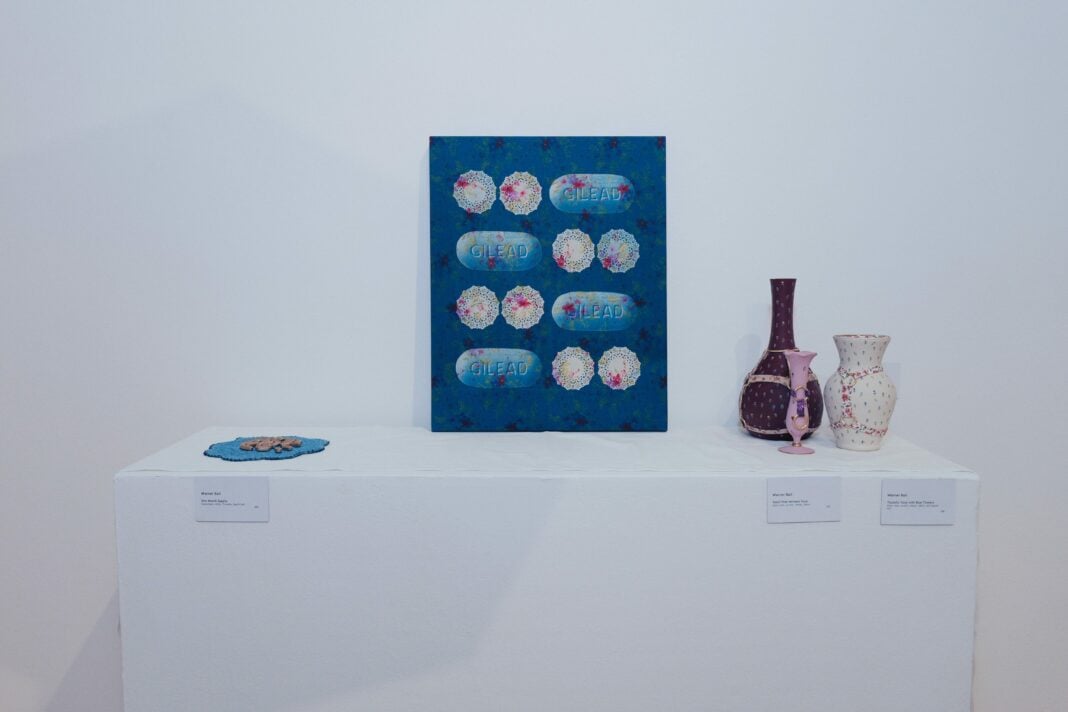With the start of summer swiftly approaching, the Indianapolis Arts Center has concluded their spring showings, cementing the end of the season. The exhibits were expertly curated, comprised of a collection of clay pieces made within the center’s own studio, sculptural display by Jennifer Crupi who has work in the possession of the Smithsonian American Art Museum, the Biannual ArtReach Exhibition, and a group show of contemporary wearable art.
Though these featured the works of both budding minds and experienced artisans, the most striking collection within the galleries was certainly that of Michigan-based artist, Warner Ball’s, first solo show, “Visions of Softness: Embracing Queer Domesticity.”
With Ball’s pieces hoping to “recontextualize queerness as something totally intertwined with domesticity,” they all put forth certain scenes and images which Ball believes to encapsulate both terms, including but not limited to, vases with harnesses on, a pile of laundry, pills coated in golden liquid leaf and cyanotypes depicting everything from condoms to lovers embracing. Furthermore, Ball’s art is reactive in its nature, as he notes that “[q]ueer art has historically been a vehicle to express trauma or depict visceral imagery as an act of rebellion against public sensibilities,” with his art seeking a softer approach to the representation of the lives of LGBTQ+ individuals.
The degree to which he has rebelled against this concept, however, is quite debatable. His pieces are, in large part, bordering on explicit in their nature and connotation, and to no particular end. A recurrent depiction within the show, and one of the few to highlight LGBTQ+ individuals directly, presents a youthful model as posed, completely naked and in an intentionally provocative manner, emitting a soft power and assurance towards that of the viewer. Without the context of other pieces which represent LGBTQ+ individuals alone and in direct discourse with the viewer, such seems somewhat stereotypical, like that of the depraved bisexual trope found within problematic media of both past and present.

Likewise, Ball’s glass vases, whose curves are accentuated with harnesses, might be creatively reminiscent of humans, yet even those entitled “Couple” lack the emotive emphasis and loving care found within the act to which they allude. Indeed, in a relationship which, for many LGBTQ+ individuals, might be the only place of solace in a world of seclusion, the light grasp of handholding can be far more sensual than any harness.
Along with their sexual motifs, a pervasive quality of the work is that they all feature prominent blue elements. Ball asserts that such is in reference to the pill Truvada, which helps treat and reduce HIV infection. This color usage is an aesthetically pleasing choice, which sees even the pile of laundry laid upon the gallery floor all dyed blue. Yet, though he might be heralding the benefits of what has been, particularly in recent decades, an exceedingly important drug, he does so at the detriment of the story he wishes to tell. For, though praise is beneficial, in excess it is but the chosen child of ostracism. Though he could make the argument that the actions depicted in his piece “Chores” couldn’t be underwent without being in a healthy state, one offered and maintained by the drug in question, it reduces LGBTQ+ life to something perpetually and inherently viewed through and tied to the notion of disease. It is thus, that though he states he is creating “a link between queer references and domestic references,” he’s really stringing along a broken chain, with connections only made by haphazardly placing one concept under the prevailing nature of another.

With a long history of dangerously associating HIV infection with the LGBTQ+ community, one which has seen many Americans view members therein as but pitied patients at best or damned wrongdoers at worst, attempting to tie together the disease with any concept of “queer domesticity,” to call it or its treatment a “queer reference,” is to further strengthen the synapses of this stigma. It is such that Ball’s assertion about his cyanotypes almost seems to support the harmful and false narrative that it is only LGBTQ+ individuals who ever need to take the drug in question, due to some flaw with themselves or the community at large.
Sanctioning such a harmful idea is most likely not the artist’s intent, indeed I believe his to be much more noble. Yet, as he is exhibiting within a state that, particularly recently, has by no means been kind or compassionate to the LGBTQ+ community, a state wherein four members within the last session of the Indiana House of Representatives proposed a bill attempting to ban gay marriage even despite the Supreme Court’s ruling of it as constitutional over a decade ago, a state wherein there’s been nationally condemned attacks upon gender affirming care, discretion ought to have been utilized as to how audiences might perceive — or misconstrue — the art in question.
For even despite the factual nature of Ball’s statements, that there exists a need for softer, more loving LGBTQ+ art, his execution of that which resides within his imagination demands a great deal of further refining. That being said, one ought to keep in mind the challenges of the task he has set out to do. Indeed, both the importance and novelty of his aims must not be neglected. It is such that, though I find his execution to be somewhat convoluted and discordant, I applaud his attempts at heralding in a new phase of gentle, non-heteronormative art and hope to have the pleasure of witnessing his artistic expression evolve in further shows. For the world needs more artists like him, who attempt and aspire in the manner he is; the world needs more artists who humanize.

Caiden Cawthon is a legally blind writer who seeks to shine a light on that not readily seen, and can be found on Instagram at @caidencawthon.





